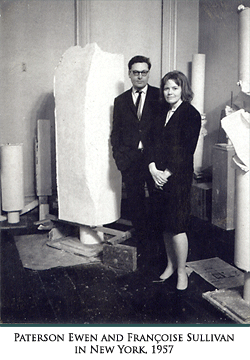 | ||||||||
| ||||||||
 | ||
As in her professional life, 1949 signified change for Sullivan's personal life. In the spring, Sullivan's student, Brian Macdonald, introduced her to a young artist named Paterson Ewen. A romance soon blossomed. A few months later, Sullivan visited New York for a month accompanied by Ewen. She enrolled in a one-month choreography intensive taught by Louis Horst. A composer, writer, editor and Martha Graham's musical advisor and collaborator, Horst also taught choreographic workshops. Pointedly, Sullivan did not go back to the Boas School of Dance; she thought Boas might not approve of her taking classes with Horst because his approach to choreography was very formalized. Again Sullivan appeared to be shifting her focus in dance. Just as she had seemingly turned her back on modern dance to return to classical ballet, now she appeared to be reversing her previous assessment that Graham's approach was too "academic" to teach a young choreographer how to communicate on her own terms. In December of 1949, Sullivan and Ewen, both twenty-four years old, wed. The couple moved into a tiny apartment on Fort Street beside the old Montréal Forum. The next year marked the birth of Vincent. More sons would soon follow: Geoffrey (June 1955), Jean-Christophe (September 1957) and Francis (August 1958).
Despite her new responsibilities as a wife and mother, the next few years were a whirlwind of choreographic projects and performances. In 1949, Sullivan provided the choreography for Monteverdi's Le Combat for the inaugural season of Opéra Minute, a chamber opera company in Montréal. Sullivan presented her choreography for Le Combat at the Fifth Canadian Ballet Festival, held at the Little Theatre in Ottawa, during the spring of 1953, performing on the same programme as the British Columbia Ballet, the Classical Ballet (Ottawa) and Willy Blok Hanson. The purpose of the Canadian Ballet Festivals, according to a submission by the Canadian Ballet Festival Association to the Royal Commission on National Development in the Arts, Letters and Sciences (1949-1951) was to create public interest in the art form as a means "to prepare a professional field for Canadian dancers, thus enabling them to earn their livelihood by the practice of their own art in their own country." For Sullivan, as for most of the 1953 Festival's participants, performing at such an event not only gave her an opportunity to meet her dance peers from across the country, but also gave her a national exposure that she had never experienced before. Sullivan reached an even larger audience with Le Combat when the work was later remounted for Radio-Canada Television, the Canadian Broadcasting Corporation's French-language station located in Montréal.
The early years of television provided work for numerous dancers and choreographers, including Sullivan. In addition to the CBC's airing of Le Combat, Sullivan choreographed several other works that appeared on CBC television. In particular, she collaborated with the composer Maurice Blackburn on Rose Latulippe, which CBC produced for the programme Allo Toronto...ici Montréal. Rose Latulippe was set in 1740 in a small town along the St. Lawrence River. A young woman is tempted by the devil, but escapes his evil clutches through the love of her family and financé. More than a decade later, Sullivan's former dance student, Brian Macdonald, would revisit this story in his own version of Rose Latulippe in a 1966 choreographic commission for the Royal Winnipeg Ballet. Other choreographic works created by Sullivan for television included Les Indes galantes (1954), Isoline (1954), Céphale et Procris (1954) and Le Tombeau de Couperin (1954), which were all featured on the weekly television show, L'heure du concert.
The advent of television was important to another choreographer, Ludmilla Chiriaeff, a Latvian artist who arrived in Montréal in 1952, eight months pregnant and with her young family in tow. She quickly opened a dance studio and discovered opportunities to choreograph for the CBC. In fact, Les Ballets Chiriaeff, the company Chiriaeff founded to have a regular group of performers appearing in her choreography for CBC, was perhaps the first dance company ever created for television. Les Ballets Chiriaeff later began to perform in theatres and eventually changed its name to Les Grands Ballets Canadiens (more recently renamed Les Grands Ballets Canadiens de Montréal). Yet, during the period when the company performed exclusively for the television camera, Sullivan often appeared with the group in choreographic works such as Les Ephémère (1953), Jeanne d'arc (1954), Esquisse (1954), Ruses d'amour (1955), Tarantelle (1955), Valses nobles et sentimentales (1955) and L'ineffable Monsieur Triquet (1955). (next page)
©2006, Dance Collection Danse | ||
 After the Les Deux Arts concert, something very odd happened. Sullivan's choreographic interests spun 180 degrees. The young woman who was quickly becoming synonymous with modern dance in Montréal returned to her first love, classical ballet. This abrupt switch was, in part, motivated by Gérald Crevier who, in 1949, founded Les Ballets Québec, an amateur ballet company comprised of his students. Crevier served as the Artistic Director and Ballet Master and John Sullivan, Françoise's father, was the Honorary President for the company, which lasted until 1952.
After the Les Deux Arts concert, something very odd happened. Sullivan's choreographic interests spun 180 degrees. The young woman who was quickly becoming synonymous with modern dance in Montréal returned to her first love, classical ballet. This abrupt switch was, in part, motivated by Gérald Crevier who, in 1949, founded Les Ballets Québec, an amateur ballet company comprised of his students. Crevier served as the Artistic Director and Ballet Master and John Sullivan, Françoise's father, was the Honorary President for the company, which lasted until 1952.